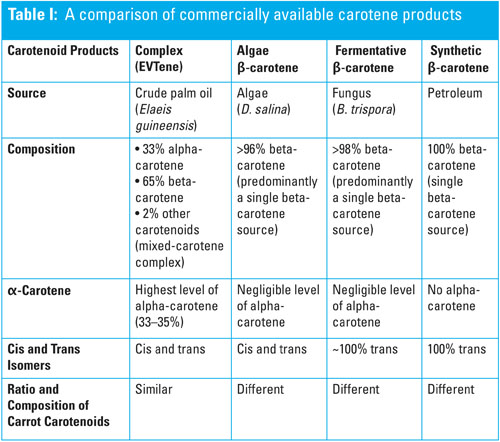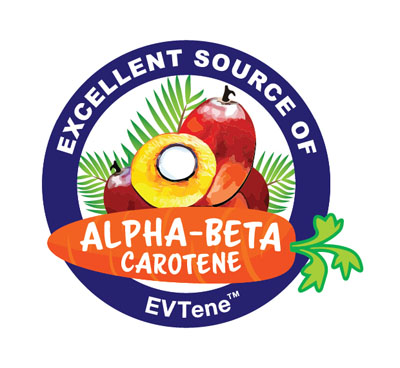EVTene is a natural mixed-carotene complex oil that’s extracted and concentrated from non-GMO Malaysian red oil palm fruit (Elaeis guineensis).
One of its unique attributes is that EVTene has a similar carotene composition to that of carrots, comprising approximately 33% alpha-carotene, 65% beta-carotene and 2% other carotenes (such as gamma-carotene and lycopene).
What’s more, EVTene’s uniqueness doesn’t end there; compared with other commercial sources of carotenes, it also boasts a number of other key attributes (Table I).
As such, in terms of the best beta-carotene or mixed carotene ingredient for a clean label product, it is clear (from Table I) that palm mixed-carotene is the only true natural mixed-carotene with the same ratio and composition as carrots. Other commercially available beta-carotene sources consist mainly of a single beta-carotene isomer, either derived from algae, a fungus or petroleum.

Mixed-carotene synergism and health
The dietary intake of natural mixed-carotene or carotenoids (a combination of alpha-carotene, beta-carotene and other carotenoid compounds) from fruit and vegetables has been shown to confer significant health effects. As a matter of fact, recent studies have demonstrated that the consumption of mixed-carotene helps to promote healthy weight among children and preserve immune health.
Healthy metabolism/weight management
An exciting study reveals that palm mixed-carotene (EVTene) is effective in modulating adipokines (a hormone secreted by adipose tissue) and abdominal adiposity in obese children.
In this randomised, double-blind, placebo-controlled intervention trial, 20 obese children (with an average age of 10.5 ) were given either two tablets of MCS (Mixed Carotenoid Supplement), consisting of 1200 µg of beta-carotene and 500 µg of alpha-carotene (from EVTene), 10 mg of lutein and 2 mg of zeaxanthin (marigold extract), 10 mg of lycopene (from tomatoes), 500 µg of astaxanthin and 10 mg of gamma-tocopherol per capsule or a placebo daily for 6 months.
Measurements of waist circumference, blood tests (serum carotenoids, total adiponectin, leptin, insulin, triglycerides, high-density lipoprotein cholesterol) and percentage change in visceral adipose tissue (VAT) and subcutaneous adipose tissue (SAT) were performed in both MCS and the placebo groups at baseline and after the supplementation period.
Compared with the placebo group, the MCS participants demonstrated a reduced BMI (Body Mass Index) z-score and WHtR (waist to height ratio), a stable HOMA-2 (homeostatic model assessment of insulin resistance-2), and elevated levels of beta-carotene, total adiponectin and HMW-ADI (high molecular weight adiponectin).
Natural mixed-carotene not only shows positive association with total adiponectin at baseline, but also a negative correlation with waist circumference (WHtR), visceral adipose tissue (VAT) and subcutaneous adipose tissue (SAT) after adjustment for sex among obese children.
It indicates that obese children supplemented with natural mixed-carotene have increased plasma adiponectin that is thought to enhance insulin sensitivity, mitigate inflammatory processes and promote heart-healthy effects. Therefore, long-term supplementation with mixed-carotene may help to regulate metabolic health in obese children.1
Immune health promotion
In this double-blind, placebo-controlled, crossover study, 36 overweight or obese male subjects were supplemented with an anti-inflammatory dietary mixture for 5 weeks, followed by a nutritional challenge test (NCT) with a high fat content.
The correlation of nutrition status with metabolic and inflammatory parameters was examined at baseline, fasting and in response to NCT using proteomic and metabolomic platforms. The nutrients being evaluated included four carotenoids (alpha-carotene, beta-carotene, beta-cryptoxanthin and lycopene), retinol, alpha- and gamma-tocopherol (vitamin E) and vitamin D3.
During fasting, plasma alpha-carotene shows an inverse relationship with proinflammatory proteins, whereas gamma-tocopherol demonstrates a high correlation with peptides that are associated with insulin sensitivity. The results suggest that alpha-carotene and gamma-tocopherol may help to attenuate inflammatory processes and blood glucose regulation, respectively.
In addition, both alpha-carotene and gamma-tocopherol indicate modulation in metabolic-inflammatory processes upon NCT. Collectively, alpha-carotene and gamma-tocopherol are important nutrients that safeguard our health from inflammatory processes that could be a contributing factor to a decline in immune health.2,3

Vision health (AMD)
A large-scale cohort study with more than 100,000 subjects published in JAMA Ophthalmol. suggested that increasing the dietary consumption of a wide variety of carotenoid-rich (lutein, zeaxanthin, alpha-carotene, beta-carotene and beta-cryptoxanthin) fruit and vegetables may reduce AMD risk.4
A Northern Indian population study reported similar findings in 2008, when significant inverse associations were found between cataract and concentrations of alpha- and beta-carotene, lycopene, zeaxanthin and beta-cryptoxanthin.5
Telomere protection
Telomeres are specialised structures at the end of each chromosome that function to minimise the loss of human genetic data during cell division. Telomere shortening is associated with accelerated ageing and a higher risk of cancer development or death. The increased intake of natural carotenoid-rich food may also play a role in protecting telomeres and regulating their length.
Reported in the 1992–2002 National Health and Nutrition Examination Survey (NHANES) that involved 3600 US adults aged 20 and older, blood levels of alpha-carotene, beta-carotene (trans- plus cis-) and beta-cryptoxanthin were associated (significantly) with longer telomeres. This signifies a potential and important role of mixed-carotenoids in delaying the ageing process and reducing the risk of age-related illnesses.6
Conclusion
When compared with synthetic and single isomers of beta carotene, natural plant-derived mixed-carotene complex is the preferred carotene ingredient for a clean label product. Clearly, plant-derived mixed-carotene (EVTene) is the best option and a good source of carotenoids for incorporation into our daily diets. In addition, the synergism from this complex of various carotenoids, as produced in nature, provides more nutritional value and better health attributes.
EVTene is extracted from sustainably sourced non-GMO Malaysian red palm fruit. In fact, the palm oil industry in Malaysia is highly regulated, with strict adherence to laws and regulations, and with high standards of sustainability. In this regard, EVTene is not only a clean, ecofriendly whole-food carotenoid supplement, but also a true natural mixed-carotene complex … as nature intended!
References
- J.A. Canas, et al., “Effects of Mixed Carotenoids on Adipokines and Abdominal Adiposity in Children: A Pilot Study,” J. Clin. Endocrinol. Metab. 102(5), 1–8 (2017).
- A. Ben-Amotz and Y. Levy, “Bioavailability of a Natural Isomer Mixture Compared with Synthetic All-Trans Beta-Carotene in Human Serum,” Am. J. Clin. Nutr. 63, 729–734 (1996).
- T.J. van den Broek, et al., “The Impact of Micronutrient Status on Health: Correlation Network Analysis to Understand the Role of Micronutrients in Metabolic-Inflammatory Processes Regulating Homeostasis and Phenotypic Flexibility,” Genes Nutr. 12, 5 (2017): doi: 10.1186/s12263-017-0553-7.
- J. Wu, et al., “Intakes of Lutein, Zeaxanthin and Other Carotenoids and Age-Related Macular Degeneration During Two Decades of Prospective Follow-Up,” JAMA Ophthalmol. 133(12), 1415–1424 (2015).
- M. Dherani, et al., “Blood Levels of Vitamin C, Carotenoids and Retinol Are Inversely Associated with Cataract in a North Indian Population,” Invest. Ophthalmol. Vis. Sci. 49(8), 3328–3335 (2008).
- K.B. Min and J.Y. Min, “Association Between Leukocyte Telomere Length and Serum Carotenoid in US Adults,” Eur. J. Nutr. 56(3), 1045–1052 (2016).
